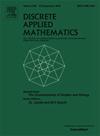Subprime and superprime graphs
IF 1
3区 数学
Q3 MATHEMATICS, APPLIED
引用次数: 0
Abstract
Let be a graph with at least four vertices. The graph is prime if all its modules are trivial. For example, for every integer , the path is prime. So the graph can be made prime by modifying the adjacency relation between some pairs of vertices, i.e., by adding some edges to and removing some other edges from it. (The first two authors proved that the graph can be made prime by at most adjacency modifications.) Nevertheless, there are graphs that cannot be made prime by only adding or only removing edges. So let us say that is superprime (resp. subprime) if it can be made prime by removing (resp. adding) edges. Given that subprime graphs are the complements of superprime ones, we have chosen to focus solely on superprime graphs, which are graphs admitting a spanning prime subgraph. These graphs are connected. They were considered by D.P. Sumner, who proved that given a connected graph with at least four vertices, is superprime if it does not admit a stable module of size 2. This sufficient condition for to be superprime is not necessary. In this paper, we provide a necessary and sufficient condition for to be superprime. This condition involves neighborhood complexes that we associate with stable sets.
次级和超素数图
设G是一个至少有四个顶点的图。如果图G的所有模都是平凡的,那么它就是素数。例如,对于每一个整数n≥4,路径Pn为素数。因此,通过修改一些顶点对之间的邻接关系,即通过向G添加一些边并从中删除一些边,可以使图G成为素数。(前两位作者证明了图G可以通过最多|个V(G)|−1个邻接修改成为素数。)然而,有些图不能仅仅通过增加或移除边而成为素数。所以我们设G是上素数。次级抵押贷款)如果它可以通过去除(p。添加)边缘。鉴于次优图是超素数图的补图,我们选择只关注超素数图,即允许生成素数子图的图。这些图是相连的。Sumner证明了给定一个至少有四个顶点的连通图G,如果它不存在大小为2的稳定模,则G是超素数。这个G是上素数的充分条件是不必要的。本文给出了G是超素数的一个充分必要条件。这个条件涉及到我们与稳定集合相关联的邻域复合体。
本文章由计算机程序翻译,如有差异,请以英文原文为准。
求助全文
约1分钟内获得全文
求助全文
来源期刊

Discrete Applied Mathematics
数学-应用数学
CiteScore
2.30
自引率
9.10%
发文量
422
审稿时长
4.5 months
期刊介绍:
The aim of Discrete Applied Mathematics is to bring together research papers in different areas of algorithmic and applicable discrete mathematics as well as applications of combinatorial mathematics to informatics and various areas of science and technology. Contributions presented to the journal can be research papers, short notes, surveys, and possibly research problems. The "Communications" section will be devoted to the fastest possible publication of recent research results that are checked and recommended for publication by a member of the Editorial Board. The journal will also publish a limited number of book announcements as well as proceedings of conferences. These proceedings will be fully refereed and adhere to the normal standards of the journal.
Potential authors are advised to view the journal and the open calls-for-papers of special issues before submitting their manuscripts. Only high-quality, original work that is within the scope of the journal or the targeted special issue will be considered.
 求助内容:
求助内容: 应助结果提醒方式:
应助结果提醒方式:


